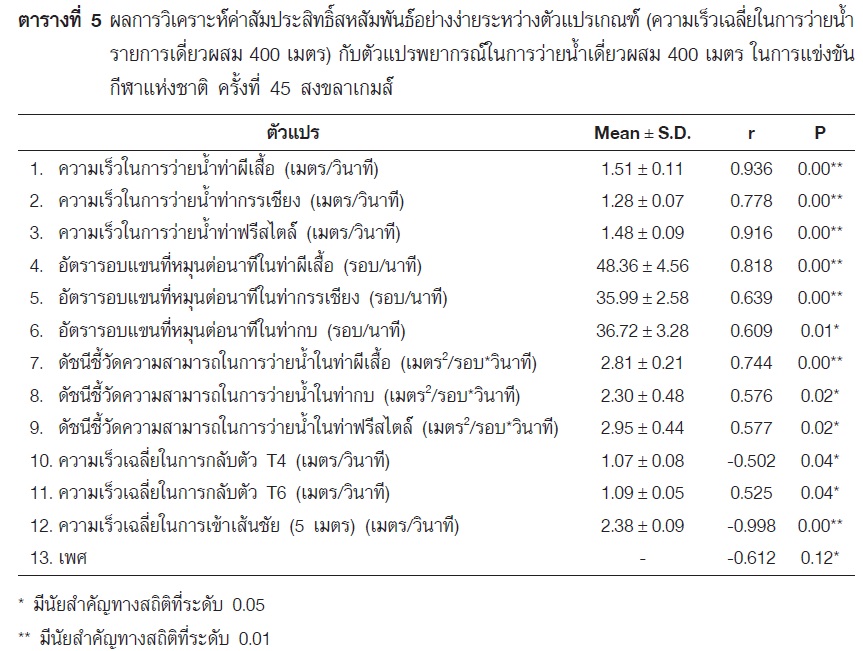ANALYSIS OF SPECIFIC SRATEGY OF THE 200M AND 400M INDIVIDUAL MEDLEY SWIMMERS IN THE 45th THAILAND NATIONAL GAME
Main Article Content
Abstract
Purposes : The purpose of this study were to study and compare specific pacing strategy between male and female swimmers and to find the correlations between swimming characteristics and 200m and 400m individual medley swimming performance at the 45th Thailand national game.
Methods : The performance of the sixteen finalist swimmers (M = 8, F = 8) competing in 200m and 400m IM events in the 45th Thailand national game was filmed at 50 Hzs and analyzed using the Dartfish software. Independent t-test was conducted to evaluate any differences in pacing strategy between male and female swimmers and a multiple linear regression was used to create the predicted equation of 200m and 400m IM swimming performance. Statistical significance was set at p ≤ 0.05.
Results : The specific pacing strategy pattern of the 200m and 400m IM swimming were similar between male and female swimmers, with a greater average swimming velocity in male than in female. The swimming velocity was the highest in butterfly, followed by freestyle, backstroke and breaststroke, respectively. The average of swimming velocity and stroke rate (SR) were significantly greater (p <0.05) in 200m than in 400m distances. In addition, The SR increases proportionately with stroke index (SI). On the contrary, stroke length (SL) increased as SR decreased. The SI was significantly greater (p <0.05) in 200m than that in 400m. The prediction equation was velocity = –0.313 + (0.549* FR speed) + (0.551* turning velocity of BU to BA) for 200m IM and was velocity = –0.010 + (0.337* BU speed) + (0.294* BA speed) + (0.250* FR speed) + (0.035* stroke index of BR) for 400m IM.
Conclusion : The analysis of specific pacing strategy of the 200m and 400m IM swimming events showed a similar pattern between male and female swimmers, with the highest velocity observed in butterfly and lowest in breaststroke. The multiple linear regression analysis revealed the key factors in predicting swimming performance of 200m and 400m IM, which can be used for designing specific training program for each swimmer.
Article Details
References
Barbosa, T. M., Fernandes, & Vilas-Boas, J. (2005). Evaluation of the energy expenditure in competitive swimming strokes. International Journal of Sports Medicine, 27(11), 894-899.
Bonifazi, M., Sardella, F., & Lupo, C. (2000). Preparatory versus main competitions: differences in performances, lactate responses and pre-competition plasma cortisol concentrations in elite male swimmers. European Journal of Applied Physiology, 82(5-6), 368-373.
Cossor, J., & Mason, B. (2001). Swim start performances at the Sydney 2000 Olympic Games. Paper presented at the ISBSConference Proceedings Archive.
Laffite, L. P., Vilas-Boas, J. P., Demarle, A., Silva, J., Fernandes, R., & Louise Billat, V. (2004). Changes in physiological and stroke parameters during a maximal 400-m free swimming test in elite swimmers. Canadian Journal of Applied Physiology, 29(S1), S17-S31.
McCabe, C. B., Psycharakis, S., & Sanders, R. (2011). Kinematic differences between front crawl sprint and distance swimmers at sprint pace. Journal of Sports Sciences, 29(2), 115-123.
Mercadé, J., B. F., Ortiz, E. M., & Contreras, G. L. (2007). Effects of different distance of swim on physiological and technical performance in front crawl swimming. Paper presented at the Swimming Science I.
Morais, J. E., A., Marinho, D., & Barbosa, T. M. (2012). Linking selected kinematic, anthropometric and hydrodynamic variables to young swimmer performance. Pediatric Exercise Science, 24(4), 649-664.
Morais, J. E., Marques, M. C., & Barbosa, T. M. (2014). Longitudinal modeling in sports: Young swimmers’ performance and biomechanics profile. Human Movement Science, 37, 111-122.
Okuno, K. (2003). Stroke characteristics of world class male swimmers in free style events of the 9th FINA world swimming championships 2001 Fukuoka. Biomechanics and Medicine in Swimming, 162.
Robertson, E. Y., Pyne, D. B., Hopkins, W. G., & Anson, J. M. (2009). Analysis of lap times in international swimming competitions. Journal of Sports Sciences, 27(4), 387-395.
Saavedra, J. M., Escalante, Y., Garcia-Hermoso, A., Arellano, R., & Navarro, F. (2012). A 12-year analysis of pacing strategies in 200-and 400-m individual medley in international swimming competitions. The Journal of Strength & Conditioning Research, 26(12), 3289-3296.
Silva, A. J., V. M., Saavedra, J., Perl, J., Marinho, D. A. (2007). The use of neural network technology to model swimming performance. Journal of Sports Science & Medicine, 6(1), 117.
Thompson, K., Haljand, R., & MacLaren, D. (2000). An analysis of selected kinematic variables in national and elite male and female 100-m and 200-m breaststroke swimmers. Journal of Sports Sciences, 18(6), 421-431.
Thompson, K., MacLaren, D., Lees, A., & Atkinson, G. (2003). The effect of even, positive and negative pacing on metabolic, kinematic and temporal variables during breaststroke swimming. European Journal of Applied Physiology, 88(4-5), 438-443.
Tor, E., Pease, D. L., Ball, K. A., & Hopkins, W. G. (2014). Monitoring the effect of race-analysis parameters on performance in elite swimmers. International Journal of Sports Physiology and Performance, 9(4), 633-636.
Toubekis, A. G., Tsami, A. P., Smilios, I. G., Douda, H. T., & Tokmakidis, S. P. (2011). Training-induced changes on blood lactate profile and critical velocity in young swimmers. The Journal of Strength & Conditioning Research, 25(6), 1563-1570.
Welsh, A. H., & Knight, E. J. (2015). “Magnitudebased inference”: A statistical review. Medicine and Science in Sports and Exercise, 47(4), 874


